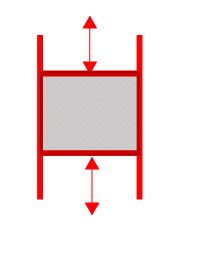1) I agree with Lo that the cost is all about the formwork so the construction tendency is to maintain a particular column size for the entire building or, at the least, a number of stories at a time. I was once told to hold the column size for ten consecutive stories at a time on very tall buildings. I don't know that there was any magic to that number though.
2) For rectangular columns, and depending on the formwork system being used, there can be merit in decreasing one side dimension of a column while holding the other. See the sketch below.
3) Particularly in low to mid-rise buildings, the uppermost columns can be some of the highest demand columns at any level. That, because bending moments tend to be similar at all levels and, at the highest level, you don't have much axial load to kind of prestress the column and reduce reinforcing tension demand.
4) Unless there is an occupancy change part way up the building, it is often of little architectural consequence whether or not column size is decreased. Whatever accommodation has been arrived at for a 15th story condo unit is often equally applicable to an 30th story condo unit.
5) For tall buildings, a popular strategy is to use high strength concrete at the lower storeys, hold the column size, and reduce the concrete strength up the height of the building. This saves on concrete costs without incurring offsetting formwork costs.

